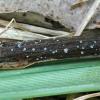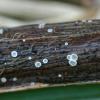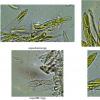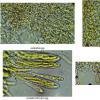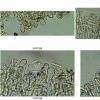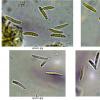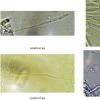
24-03-2017 23:12
 Bernard CLESSE
Bernard CLESSE
Bonsoir à tous,Voici ce que je pense être un Mol

23-03-2017 20:56
 Viktorie Halasu
Viktorie Halasu
Hello,my friend is looking for the paper by Granmo

24-03-2017 11:08
This was found on fallen twigs in deciduous wet wo

23-03-2017 18:44
 Blasco Rafael
Blasco Rafael
Hola, a ver si me pueden ayudar con esta muestra,

23-03-2017 14:55
En madera sin determinarPienso en Lasiobelonium va

22-03-2017 23:22
 William Slosse
William Slosse
I found following species in the garden on the und

22-03-2017 23:25
 Bernard CLESSE
Bernard CLESSE
Bonsoir à tous,Quel est cet asco poussant sur pé
Mollisia (?) sur Carex acutiformis
Bernard CLESSE,
24-03-2017 23:12
 Bonsoir à tous,
Bonsoir à tous,Voici ce que je pense être un Mollisia sur feuilles pourries et imbibées de Carex acutiformis.
a) asques IKI+, à crochet à la base
b) paraphyses graduellement élargies vers l'extrémité
c) spores étroitement fusiformes, arquées : 12-14x2
d) excipulum à textura globosa
e) poils clavés, trapus, courtement pubescents
Qu'en pensez-vous ?
Bernard
Hans-Otto Baral,
25-03-2017 07:22

Re : Mollisia (?) sur Carex acutiformis
I don't see living paraphyses (probably because of the IKI), but this should be without VBs.
Obviously Cistella albidolutea (the short hairs should be around 7-9 µm wide).
Obviously Cistella albidolutea (the short hairs should be around 7-9 µm wide).
Bernard CLESSE,
25-03-2017 08:06

Re : Mollisia (?) sur Carex acutiformis
Hi Zotto,
Great thanks for your message ! I'll recheck living paraphyses in water and I'll control hairs sizes.
Bernard
Great thanks for your message ! I'll recheck living paraphyses in water and I'll control hairs sizes.
Bernard
Bernard CLESSE,
25-03-2017 09:18
Hans-Otto Baral,
25-03-2017 09:31

Re : Mollisia (?) sur Carex acutiformis
Yes, the hairs fit perfectly. But the paraphyses are dead on your pics. Anyhow it confirms my ID.
Bernard CLESSE,
25-03-2017 10:32

Re : Mollisia (?) sur Carex acutiformis
OK Zotto, thank you.
Bernard
Bernard
